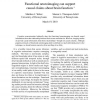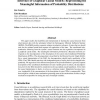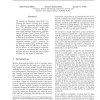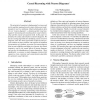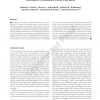124
click to vote
JOCN
2010
14 years 7 months ago
2010
Cognitive neuroscientists habitually deny that functional neuroimaging can furnish causal information about the relationship between brain events and behavior. However, imaging st...
123
Voted
JMLR
2010
14 years 7 months ago
2010
This paper studies the feasibility and interpretation of learning the causal structure from observational data with the principles behind the Kolmogorov Minimal Sufficient Statist...
126
click to vote
JMLR
2010
14 years 7 months ago
2010
Current methods for causal structure learning tend to be computationally intensive or intractable for large datasets. Some recent approaches have speeded up the process by first m...
106
click to vote
JMLR
2010
14 years 7 months ago
2010
: This review presents empirical researchers with recent advances in causal inference, and stresses the paradigmatic shifts that must be undertaken in moving from traditional stati...
127
click to vote
JMLR
2010
14 years 7 months ago
2010
Directed acyclic graph (DAG) models are popular tools for describing causal relationships and for guiding attempts to learn them from data. In particular, they appear to supply a ...
118
Voted
JMLR
2010
14 years 7 months ago
2010
We present an algorithm name cSAT+ for learning the causal structure in a domain from datasets measuring different variable sets. The algorithm outputs a graph with edges correspo...
112
click to vote
FAST
2009
14 years 10 months ago
2009
Versioning file systems provide the ability to recover from a variety of failures, including file corruption, virus and worm infestations, and user mistakes. However, using versio...
103
click to vote
VL
2010
IEEE
14 years 11 months ago
2010
IEEE
The principle of causation is fundamental to science and society and has remained an active topic of discourse in philosophy for over two millennia. Modern philosophers often rely...
111
click to vote
JOCN
2010
14 years 11 months ago
2010
■ Knowledge about cause and effect relationships (e.g., virus– epidemic) is essential for predicting changes in the environment and for anticipating the consequences of events...
121
click to vote
PRESENCE
2007
15 years 14 days ago
2007
Causality is an important aspect of how we construct reality. Yet, while many psychological phenomena have been studied in their relation to virtual reality (VR), very little work...
